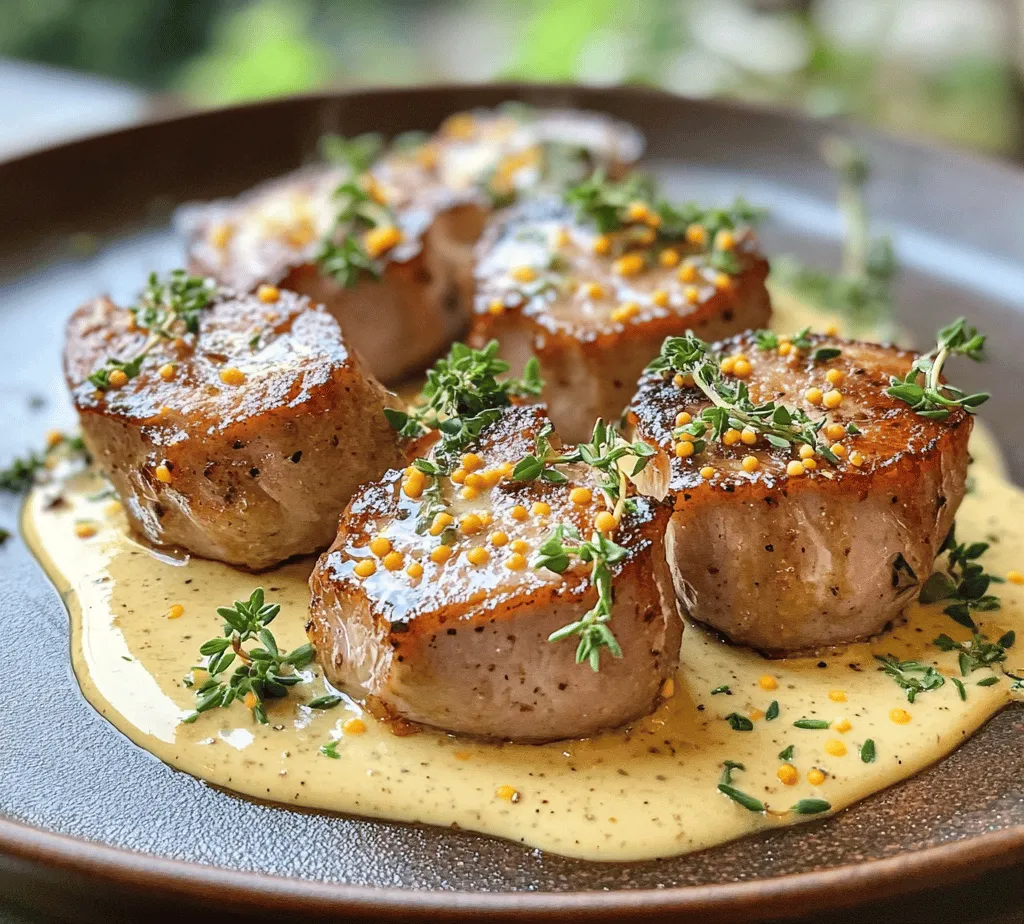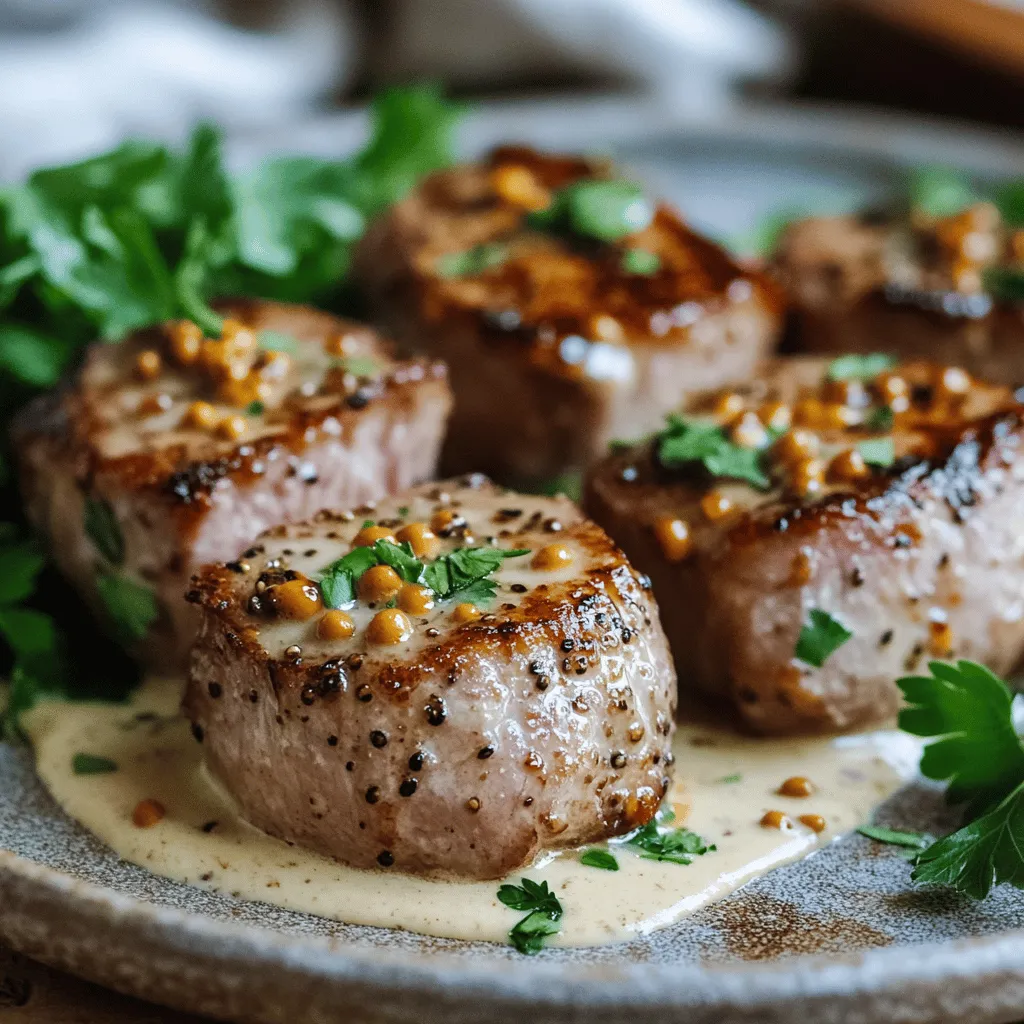Introduction
Pork Tenderloin with Creamy Mustard Sauce is a delightful dish that brings together the succulent flavors of tender pork and a rich, velvety mustard sauce. This recipe appeals to both seasoned home cooks and beginners alike, thanks to its simplicity and the elegance it brings to any dining table. The combination of savory pork and the creamy, tangy sauce creates a symphony of flavors that can elevate a weeknight dinner into a special occasion feast.
Pork tenderloin, known for its tenderness and mild flavor, is a versatile protein choice that can be prepared in various ways. Whether grilled, roasted, or sautéed, this cut of meat absorbs flavors beautifully, making it a favorite among chefs and home cooks. The creamy mustard sauce, in particular, enhances the pork’s natural taste, creating a dish that is not only satisfying but also visually appealing.
This recipe is perfect for those who want to impress guests without spending hours in the kitchen. With a handful of ingredients and straightforward steps, you can create a restaurant-quality meal that showcases your culinary skills. Let’s dive into the details of this delectable dish, starting with an understanding of pork tenderloin itself.
Understanding Pork Tenderloin
Pork tenderloin is a long, thin cut of meat that comes from the muscle that runs along the spine of the pig. This cut is prized for its tenderness, making it one of the most sought-after cuts of pork. Its mild flavor allows it to pair well with a variety of seasonings, making it a versatile choice for countless recipes.
One of the main reasons pork tenderloin is popular among home cooks is its quick cooking time. Unlike tougher cuts of meat that require slow cooking, pork tenderloin can be prepared in under 30 minutes, making it an ideal option for busy weeknights. Additionally, it’s a lean cut of meat, which means it has less fat than other pork cuts, making it a healthier choice.
Nutritional Benefits of Pork Tenderloin
In addition to its culinary appeal, pork tenderloin is a nutritious option. It is an excellent source of lean protein, which is essential for muscle repair and growth. A 3-ounce serving of cooked pork tenderloin contains approximately 22 grams of protein, making it a filling choice that can support a balanced diet.
Moreover, pork tenderloin is rich in essential vitamins and minerals, including B vitamins like niacin and B6, which play a crucial role in energy metabolism and brain health. It also provides important minerals, such as phosphorus and selenium, which are vital for bone health and immune function respectively.
When selecting pork tenderloin, freshness is key. Look for meat that is pinkish-red in color, with a firm texture and minimal marbling. Avoid any cuts that appear dull or have a grayish hue, as these may be past their prime.
Tips for Selecting the Best Pork Tenderloin
When shopping for pork tenderloin, consider the following tips to ensure you choose the best cut:
1. Check the Label: Look for pork labeled as “natural” or “organic,” which often indicates that the meat is free from antibiotics and artificial hormones.
2. Inspect the Color: Fresh pork tenderloin should have a bright, pinkish-red color. Avoid meat that looks gray or has dark spots.
3. Feel the Texture: The meat should feel firm and slightly moist to the touch. Avoid cuts that feel slimy or sticky, as this can indicate spoilage.
4. Consider the Size: Pork tenderloins typically weigh between 1 to 2 pounds. For most recipes, a 1.5-pound tenderloin is a good size to serve 4 people, allowing for leftovers or a hearty serving.
5. Storage Tips: If you’re not cooking the pork tenderloin immediately, store it in the refrigerator for up to 3 to 5 days or freeze it for longer storage. When freezing, wrap the meat tightly to prevent freezer burn.
Ingredients Breakdown
Now that we’ve established a foundation for understanding pork tenderloin, let’s delve into the ingredients that will make this dish shine. Each component plays a significant role in enhancing the flavors of the pork and creating a delicious creamy mustard sauce.
Pork Tenderloin
The star of this dish is, of course, the pork tenderloin itself. When preparing this recipe, aim for a tenderloin that weighs between 1 to 1.5 pounds. This size is perfect for roasting and yields a juicy, flavorful result. Prior to cooking, trim any excess fat or silver skin to ensure a tender bite.
Seasoning: Salt and Pepper
The importance of seasoning cannot be overstated. A generous sprinkle of salt and freshly cracked black pepper will enhance the natural flavors of the pork. Seasoning not only adds taste but also helps to form a delicious crust during cooking, sealing in the juices and ensuring a moist final product.
Olive Oil
Olive oil plays a crucial role in the cooking process, adding flavor while helping to achieve a beautifully browned exterior on the tenderloin. When selecting olive oil, choose extra virgin for its robust flavor and health benefits. This oil is rich in monounsaturated fats and antioxidants, making it a heart-healthy choice.
Onions and Garlic
Onions and garlic are the foundational flavors for the creamy mustard sauce. Sautéing these aromatics in olive oil releases their natural sweetness, which balances the tanginess of the mustard. Onions provide a subtle sweetness while garlic adds depth and richness to the sauce. Both ingredients come with health benefits, including anti-inflammatory properties and support for heart health.
Chicken Broth
Chicken broth is a key ingredient for deglazing the pan after searing the pork. It helps to lift the flavorful bits stuck to the bottom of the pan, ensuring that none of the deliciousness goes to waste. You can use homemade chicken broth for the best flavor, but store-bought options are convenient and work well. Look for low-sodium varieties to control the salt content in your dish.
Mustards
The choice of mustard is crucial in this recipe, as it is the primary flavoring agent in the sauce. Dijon mustard offers a smooth, tangy profile, perfect for creating a rich sauce, while whole grain mustard adds texture and a bold flavor. You can use one or a combination of both to achieve your desired taste. Experimenting with different mustards can also add a unique twist to the dish.
Heavy Cream
Heavy cream is what gives the sauce its luxurious texture and richness. It balances the sharpness of the mustard, creating a creamy, luscious sauce that coats the pork beautifully. If you’re looking for a lighter alternative, consider using half-and-half or a combination of Greek yogurt and broth to achieve a similar creamy effect without the extra calories.
With these key ingredients at hand, you’re ready to embark on the journey of preparing Pork Tenderloin with Creamy Mustard Sauce. In the next section, we will explore the step-by-step instructions for bringing this delicious dish to life, ensuring that your meal is both flavorful and satisfying. Stay tuned for the detailed preparation process that will guide you from start to finish in creating this culinary masterpiece.

Fresh Herbs: The Role of Thyme and Parsley in Flavor and Presentation
Fresh herbs can transform a dish from ordinary to extraordinary, and in the case of Pork Tenderloin with Creamy Mustard Sauce, thyme and parsley play pivotal roles. Thyme, with its earthy and slightly minty flavor, complements the savory notes of the pork and the tangy mustard sauce. It infuses the dish with warmth that makes it feel more robust and comforting. Parsley, on the other hand, adds a fresh, peppery brightness that balances the richness of the cream and mustard. When used as a garnish, it not only enhances the flavor profile but also elevates the dish’s presentation, making it visually appealing on the plate.
Preparation Steps
Prepping the Pork Tenderloin
Before cooking, it’s crucial to properly prepare the pork tenderloin. Start by removing it from the packaging and placing it on a clean cutting board. Pat the pork dry with paper towels to eliminate any excess moisture. This step is vital because moisture can prevent the meat from achieving that beautiful, golden-brown crust during searing. Once dried, generously season the pork with salt and freshly cracked black pepper. This simple seasoning will enhance the natural flavors of the meat and create a delicious crust when cooked.
Searing Technique
Searing is an essential cooking technique that locks in flavor and moisture. To achieve the perfect golden-brown crust on your pork tenderloin, heat a large oven-safe skillet over medium-high heat and add a tablespoon of oil, such as olive oil or canola oil. Once the oil is shimmering, gently place the seasoned pork tenderloin in the skillet. Avoid overcrowding the pan, as this can lead to steaming rather than searing. Allow the pork to cook undisturbed for about 4-5 minutes, or until a golden crust forms. Using tongs, carefully turn the pork to sear all sides, achieving that beautiful caramelization that adds depth of flavor.
Oven Roasting
After searing, it’s time to finish cooking the pork in the oven. Preheat your oven to 400°F (204°C). Once the pork is evenly browned, transfer the skillet to the preheated oven. Roast the pork tenderloin for about 15-20 minutes, or until the internal temperature reaches 145°F (63°C). This temperature ensures that the pork is juicy and tender but still safe to eat. Use an instant-read thermometer to check the temperature for accuracy. Once done, remove the skillet from the oven and cover the pork loosely with aluminum foil. Allowing it to rest for 5-10 minutes will help redistribute the juices throughout the meat, keeping it moist when sliced.
Making the Creamy Mustard Sauce
While the pork is resting, it’s time to make the creamy mustard sauce. Start by adding a little more oil or butter to the skillet over medium heat. Once melted, add minced garlic and chopped shallots to the pan, sautéing until fragrant and translucent, which takes about 2-3 minutes. Next, add a splash of white wine or chicken broth, scraping the bottom of the pan with a wooden spatula to incorporate the browned bits (fond) left from searing. This deglazing process is essential as it adds intense flavor to your sauce.
Once most of the liquid has evaporated, lower the heat and stir in heavy cream, Dijon mustard, and whole grain mustard. Bring the mixture to a gentle simmer, allowing it to thicken slightly. Continue to stir for about 5-7 minutes until you achieve a creamy consistency. Taste the sauce and adjust the seasoning with salt, pepper, and a squeeze of lemon juice to brighten the flavors.
The Science of Deglazing
Deglazing is a crucial step in making a flavorful sauce. The fond that forms in the bottom of the pan during searing is packed with concentrated flavor. By adding liquid, you can lift these delicious bits off the bottom, incorporating them into your sauce for a deeper taste. It’s a simple yet effective technique that elevates the overall flavor profile of your dish.
Sauce Consistency
When making the sauce, the right consistency is essential for coating the pork and enhancing its flavors. If the sauce is too thin, allow it to simmer a bit longer; this will evaporate excess liquid and thicken it up. On the other hand, if your sauce is too thick, you can thin it out by adding a splash of broth or cream. Aim for a smooth, creamy sauce that clings beautifully to the meat but is not so thick that it overpowers the dish.
Serving Suggestions
Presentation Tips
To create an inviting presentation, slice the rested pork tenderloin into ½-inch thick medallions. Arrange the slices on a warm plate, slightly overlapping them for a restaurant-style look. Drizzle the creamy mustard sauce generously over the pork, allowing some to pool around the edges for visual appeal. Finally, sprinkle fresh chopped parsley and thyme over the dish to add a pop of color and freshness.
Recommended Side Dishes
Pork tenderloin pairs beautifully with a variety of side dishes that complement its rich flavors. Consider serving it with creamy mashed potatoes or garlic roasted potatoes for a comforting touch. Additionally, roasted seasonal vegetables, such as carrots, Brussels sprouts, or green beans, add a nutritious balance to the meal. A light salad with mixed greens, nuts, and a vinaigrette can also provide a refreshing contrast to the richness of the pork and sauce.
Wine Pairings
To enhance your dining experience, choose a wine that complements the flavors of the pork and the creamy mustard sauce. A medium-bodied white wine, such as Chardonnay or Pinot Grigio, works beautifully, as their acidity cuts through the richness of the dish. For red wine lovers, a light-bodied Pinot Noir offers a nice balance without overpowering the flavors of the pork.
Nutritional Information
Pork tenderloin is a lean cut of meat that provides an excellent source of protein while being lower in fat compared to other cuts. A typical serving (approximately 3 ounces) of pork tenderloin contains about 165 calories, 24 grams of protein, and 7 grams of fat. The accompanying creamy mustard sauce adds richness and flavor but also contributes additional calories and fat, primarily from the cream.
Portion control is key to maintaining a balanced diet. Enjoying a moderate serving of this dish, accompanied by fresh vegetables and whole grains, can fit well into a healthy eating plan.
Conclusion
Pork Tenderloin with Creamy Mustard Sauce is a dish that marries ease and elegance, making it perfect for family dinners or special occasions. The succulent pork paired with the rich, tangy sauce creates a delightful flavor experience that is sure to impress your guests. With just a few preparation steps and simple ingredients, you can prepare a meal that feels gourmet without the extensive effort.
We encourage you to try this recipe and savor the wonderful flavors it offers. Its versatility allows it to shine on any dining table, whether it’s a cozy weeknight dinner or a festive gathering. Embrace the process, enjoy the cooking journey, and relish the delicious results!


